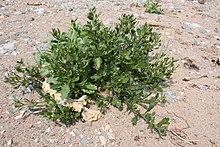American searocket
| Cakile edentula | |
|---|---|
 |
|
| Scientific classification | |
| Kingdom: | Plantae |
| (unranked): | Angiosperms |
| (unranked): | Eudicots |
| (unranked): | Rosids |
| Order: | Brassicales |
| Family: | Brassicaceae |
| Genus: | Cakile |
| Species: | C. edentula |
| Binomial name | |
|
Cakile edentula (Bigelow) Hook |
|
Cakile edentula, the American searocket, is a species of the flowering Cakile plant. This plant is native to North America.
Cakile edentula is most commonly found on the beaches and dunes of North America. More commonly, it is found on the East coast of the United States. American sea-rocket is most likely to be found in areas along the coastline. This plant is not a wetland plant, but can occasionally be found in wetland environments. It is also a non-native, invasive species of anywhere else in the world, especially of Japan and Australia.
Cakile edentula grows on the dunes of coastal beaches, as well as shorelines of freshwater lakes. Well drained, sandy soil is preferred. It is likely to be found in areas midway up beaches, out of the range of waves and tides, which can destroy individuals, especially through storm events. Cakile edentula has the life cycle of an annual plant in Northern latitudes. In warmer climates, it survives as a biennial if possible.Cakile edentula grows roots more aggressively and intensively if a nearby competitor is sensed. The plant does not react this way if the nearby competitor is kin.
Individuals of this species are succulent plants with thick, edible leaves. This plant grows as a short shrub on beaches. Leaves, one per node, alternately grow on the stem. These leaves have various teeth and lobe patterns.
Flowers are separate, radially symmetrical, and contain four petals. These flowers can be pink to red, blue to purple, or white. Fruit are small and green, about 1-2 centimeters in diameter. These fruit are dry and do not split open when ripe. Fruit are released at the end of each growing season.
...
Wikipedia
